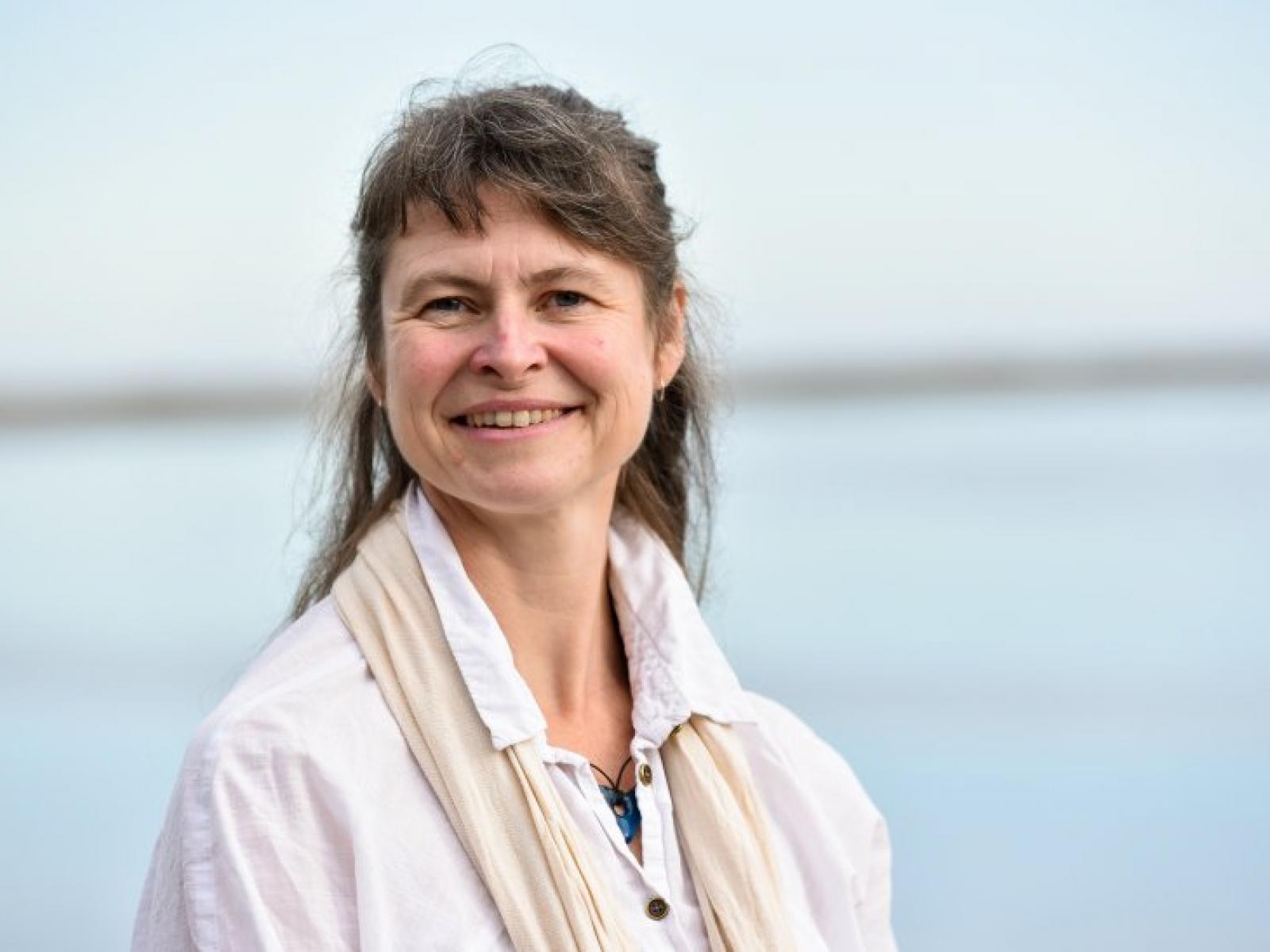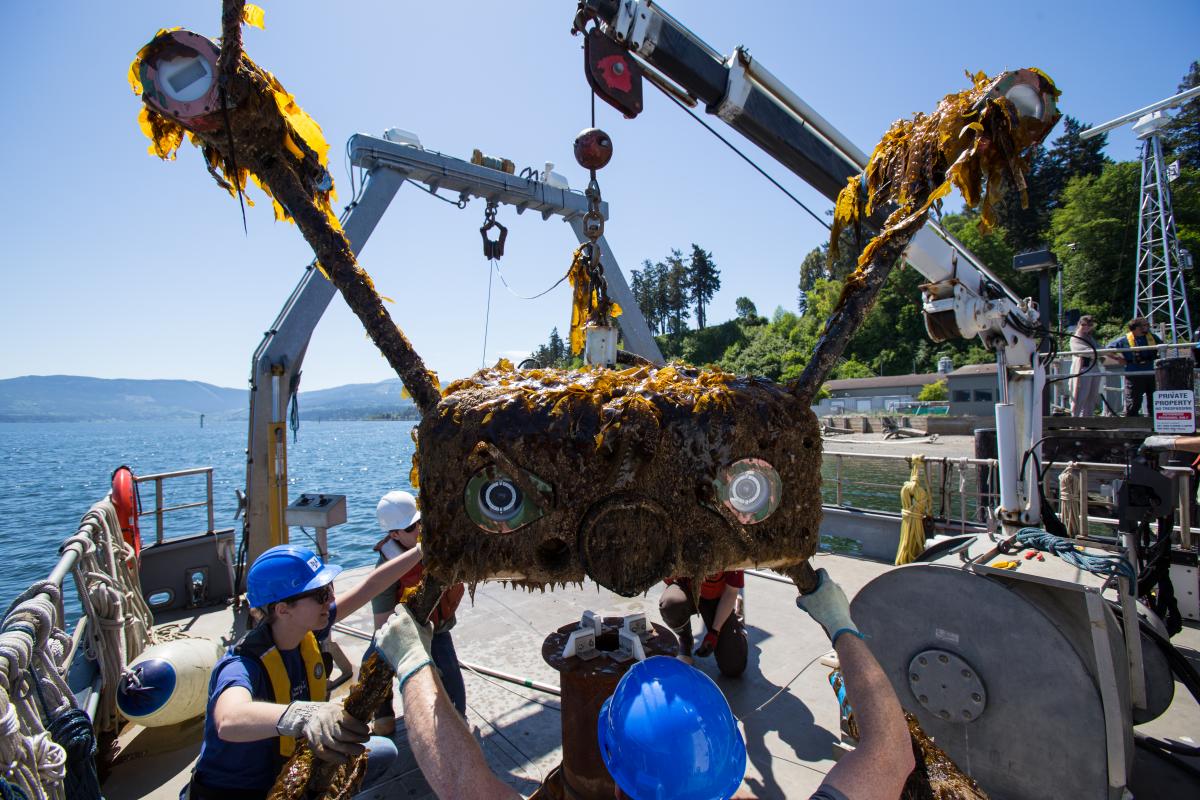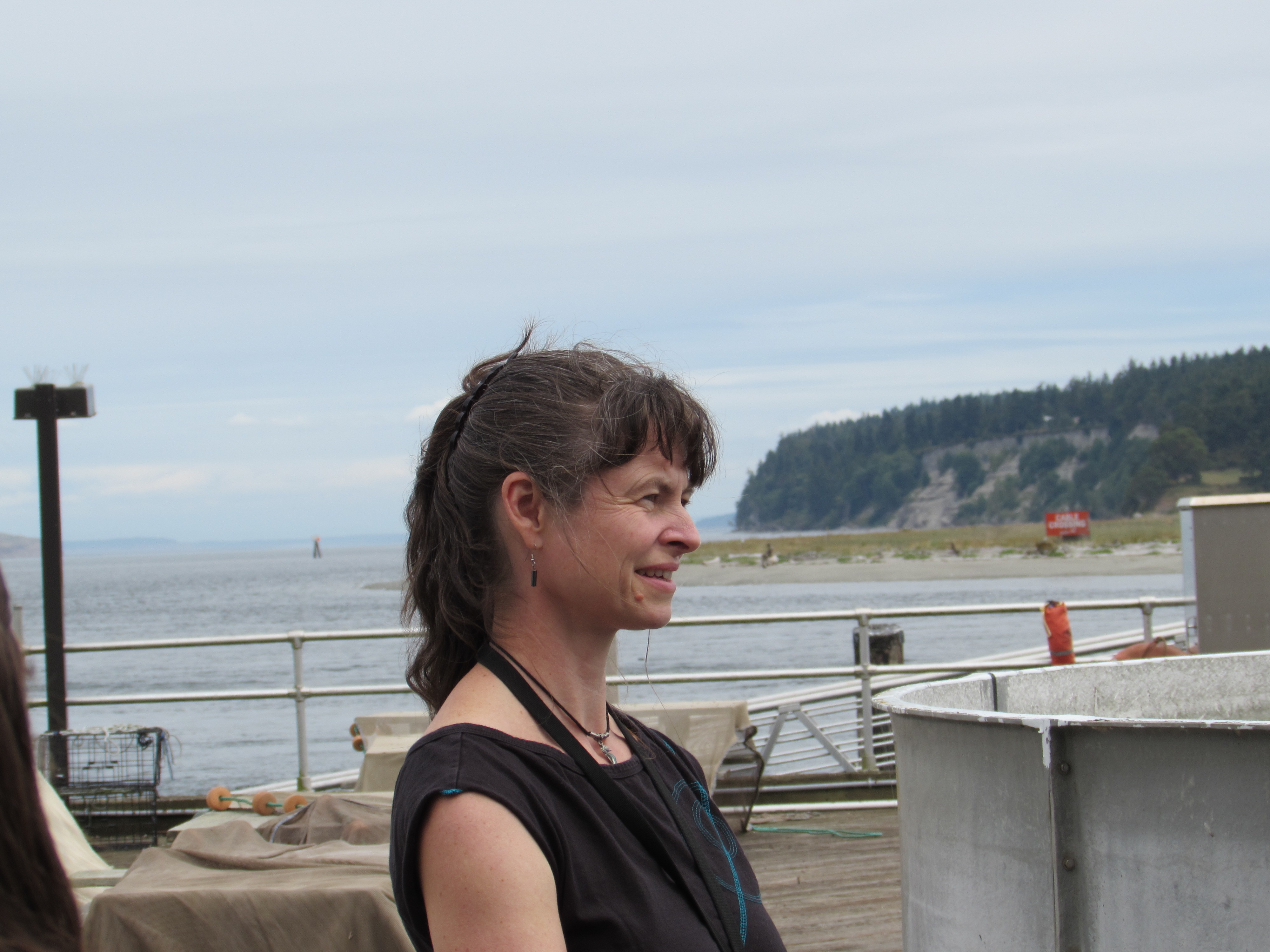Triton's Genesis: Celebrating World Oceans Month with Genevra Harker-Klimeš

Pacific Northwest National Laboratory's Coastal Science Division Director Genevra Harker-Klimeš smiles on the dock of the Marine and Coastal Research Laboratory.
(Photo by Andrea Starr | Pacific Northwest National Laboratory)
Making up 71 percent of the world's surface, the ocean is a kaleidoscope of marine life and geological wonders, most of which remain undiscovered by humans. Scientists believe the ocean holds the secrets to powering a clean and sustainable future with its waves, currents, and tides. To celebrate World Oceans Month, I interviewed Genevra Harker-Klimeš, an ocean scientist and creator of the Triton Initiative. This behind the scenes look shares how her passion for the big blue turned into a career dedicated to harnessing energy from marine and coastal systems through scientific research.
Harker-Klimeš is a physical oceanographer with a background in the dynamics of tides, currents, and waves, and interactions between the ocean and atmosphere. She leads over 70 staff as the division director of the Coastal Sciences Division (CSD) at PNNL. She acts as a visionary and supporter for diverse discovery in ocean sciences, including research in algal biofuels, coastal ecosystem resiliency, environmental biogeochemistry, coastal modeling, and marine energy.
Her colleagues often describe her as the architect who helped draw Triton's blueprint and laid the groundwork for it to grow. Triton is a U.S. Department of Energy (DOE) Water Power Technologies Office project that started small, with a team of a few scientists led by Harker-Klimeš. In the beginning phase of Triton, the team worked toward creating a space to develop and test innovative environmental monitoring technologies for marine energy applications. Since the early days, when Harker-Klimeš was leading the project, it has blossomed into a multi-project initiative that assists the development of these technologies and conducts research on the potential stressors of marine energy systems on the environment and methods to study them. Triton's mission to understand potential impacts to progress the marine energy industry forward in an environmentally safe and sustainable manner stayed the same, but the team has grown substantially. This evolution was all made possible thanks to her hard work and dedication as the initiative's first project manager.
Harker-Klimeš offers some insight into her approach to leadership. “From my experience working unconventionally, I encourage staff to explore different working styles and nourish dynamic teams. When people are happy, they produce the most outstanding results,” which is one reason her teams are so successful.
A world of experience
Harker-Klimeš explored the ocean in every corner of the world before she grew roots near the Pacific Ocean in Sequim, WA, at PNNL's Marine and Coastal Research Laboratory (MCRL). She originally hails from the United Kingdom. She began her route in science studying geography and geology, focused mainly on volcanoes and coastal environments. Her affinity for the ocean soon led her to study physical oceanography at Bangor University in Wales, where she received her master's degree and PhD. Harker-Klimeš describes her experience as “nothing going to plan but learning and growing through every obstacle” and a chapter filled to the brim with adventures and opportunities that created a solid foundation for her future. Her time in university provided research opportunities from the Arctic Circle to the world's clearest waters in New Zealand; along the way she developed essential skills in fieldwork, laboratory work, and computer science. She continued her life at sea, working as a project manager for an oceanographic survey company. She spent her days on oil rigs and vessels, often as the only woman. She reflects on this experience as an opportunity to adapt to different working styles, communicate with opinionated stakeholders, and prove herself a strong, persistent, and capable contributor despite gender discrimination. Harker-Klimeš carried this energy with her as an advocate for diversity and inclusion as she continued her career.
After many years at sea, she sought a balance between offshore travels and terrestrial roots and became an environmental consultant for offshore wind projects, a budding industry at the time. She entered the world of offshore wind before anyone knew how to deploy turbines on the water, gaining a lot of experience in legislation and policy writing that made implementing new technologies possible. As a consultant, her work bounced around the United Kingdom, France, and the United States, coordinating environmental surveys, writing and translating technical reports in different languages, and creating budgets for offshore wind developments.
During this chapter of her career, Harker-Klimeš split her time between France and New Zealand, working as a freelance consultant by night and singing as a professional musician by day. Not only did this give her the freedom to pursue multiple passions, but proved to benefit the offshore wind projects and allowed her to move work forward while her faraway colleagues were sleeping. She reminisces, “clients were pleased when they would wake up and find a report finished that they could review and submit,” all while being able to pursue the dream of singing.
After seven years of living and working bi-nationally, Harker-Klimeš soon craved something new and wanted to expand her portfolio beyond the wind industry. In 2015, she was hired at PNNL as a project manager for what would become the Triton Initiative.
Creating Triton
When she first arrived at PNNL, Harker-Klimeš was introduced to the Marine Energy Environmental Testing Initiative—or MEET. This project was proposed to DOE by Andrea Copping and Simon Geerlofs to establish a testing venue for marine energy environmental monitoring technologies. The idea was to make it possible to develop and test technologies quickly to help the emerging industry gain approvals for tidal and wave energy device deployments.
The Marine Energy Environmental Testing Initiative soon became Triton. In Greek mythology, Triton is the son of Poseidon and Amphitrite and was named herald of the sea, carrying a twisted conch with which he could calm or raise the waves. Like its namesake, the Triton Initiative aims to be the messenger for the ocean about how marine energy can be harnessed sustainably, without harm to the ocean’s residents. This etymology is a link to Triton's sister project Tethys, a knowledge base of environmental monitoring information about marine and wind energy, and an ode to Tethys, goddess of the sea.

At first, Triton's goal was uncertain because the needs of the industry were still ambiguous. Harker-Klimeš was able to draw on her experience in the early days working with the offshore wind industry to help guide Triton's direction. Initially, the initiative's main objective was to support DOE-funded partners in developing innovative technologies for monitoring different aspects of the marine environment around wave and tidal energy devices. DOE saw value in establishing a consistent testing facility linked to a national laboratory, so the project aimed to establish Sequim Bay at MCRL as a research testbed. Triton supported the 2014 DOE Funding Opportunity Announcement awardees, including the first version of the University of Washington Adaptable Monitoring Package. MCRL was not yet set up to partner with projects and conduct on-site testing, so this first phase of Triton involved quite a bit of permitting, logistics, and determining success metrics to measure effectiveness for this new industry.
While Harker-Klimeš was project manager, Triton supported the 2016 DOE Funding Opportunity Announcement awardees and established a three-phase approach where MCRL: supported the establishment of prototype technologies during the first phase; hosted awardees at the testbed in Sequim Bay to support baseline testing and benchmark improvements in the second phase; and prepared the technologies for the third phase of deployment in higher-energy environments around real devices. Harker-Klimeš also supported the design and pilot of the Triton Fish Mesocosm Study, which conducted fish behavior studies on tagged fish deployed around a sensor package in Sequim Bay. This study helped inform fish behavior research to understand potential collision risk between fish and tidal turbines.
One of the challenges related to innovative research technology is cost. The economies of scale associated with new technologies make it hard for marine energy device developers to afford the cost of developing a device and conducting necessary environmental monitoring. DOE wanted to research how to lower costs of environmental monitoring technologies and decrease barriers to marine energy device implementation. Discussions with various stakeholders in the industry, government, and PNNL around this topic informed the development of the Triton Field Trials (TFiT). This project launched Triton into the second phase of mission-driven work for DOE’s Water Power Technologies Office. The current projects associated with TFIT include streamlining methods and technologies used to monitor potential environmental stressors through field testing. This work strives to improve the cost-effectiveness of these technologies and write a set of recommendations for stakeholders on best practices for monitoring underwater noise, collision risk, changes in habitat, and electromagnetic fields around wave and tidal energy devices. The recommendations also help regulators with the permitting process that relies heavily on monitoring the environment around devices in diverse habitats and how changes impact different species. The implementation of this project excites Harker-Klimeš because it informs a wide array of stakeholders about effective environmental monitoring and the technology recommended to execute it.
From the beginning, Harker-Klimeš knew Triton would need to engage with stakeholders in the industry, such as regulators and developers, to be most impactful. In the early stages of Triton, she engaged with stakeholders and set the stage for collaborations. She is pleased to see this work continue through the TFiT recommendations. She also appreciates the value of creative communications through storytelling and web features. “I am thrilled about the recently funded communications, outreach, and engagement task to share all of the work Triton has accomplished to help move marine energy and the technologies for monitoring the environment forward.”
Harker-Klimeš reflects on the fact that Triton has come full circle in many ways. The topics she hoped to research at the birth of Triton were too grand for the budget at the time, but they are now being tackled as the team evolves. "It has been so great to see Triton build and get bigger. The value of it is very apparent," says Harker-Klimeš.
Looking to the future
Harker-Klimeš is a natural-born leader, quickly climbing the ladder from project manager of the Triton Initiative to the role of technical group manager for the CSD in 2018, and division director in early 2019. The combination of her scientific prowess, field experience, and artistic sensibilities serve her well as she guides the CSD. While she loves research and working offshore, her position as division director enables her to amplify project successes and be a voice for marine science in the energy sector. Traditionally, DOE has not focused a lot of attention on marine sciences, but it is a tremendous resource and should be a central part of our energy and climate solutions. During her time at PNNL, Harker-Klimeš has worked with DOE to implement the studies necessary to help expand marine energy's role in the United States' energy profile. She is determined to make sure PNNL can keep offering the facilities and expertise required to continue contributing to this mission.
Triton is a case study of how a project’s success supports the DOE mission. The initiative has inspired enthusiasm and curiosity, leading to the growth of other marine projects like Powering the Blue Economy. “Triton is an example of how we can expand an environmental monitoring project into other applications that make a difference," says Harker-Klimeš. "It’s kind of like a proof of concept." She is proud of the recognition Triton is getting for its expertise in underwater operations and a range of monitoring techniques that create a broad picture of potential impacts.
When asked about what she envisions for Triton's future, she responds with a smile, saying, "I am proud of the leadership that has taken over Triton and trust that the current leadership will help Triton head in the right direction, whatever that may be." She is happy to see the project is looking at aspects of marine energy systems that might stress the environment and how those stressors affect the behavior of mammals, fish, benthic invertebrates, and other marine beings impacted by those stressors. Looking at these stressor-receptor interactions helps build knowledge around marine energy systems and contributes to understanding the ocean as a larger ecosystem.
Everyone who knows Harker-Klimeš can see her passion for the ocean as she speaks. Through her travels, she knows its power and believes in its potential to help humans live a sustainable future. She offers some final thoughts: "I like how dynamic and changing the ocean is. When the sea is calm, it has amazing tranquility, and watching a sunset over a calm sea is just phenomenal. However, the ocean is also an incredibly strong force, and I’ve seen the damage it can do–the power within it is remarkable. It really helps you put life in perspective. No matter what its mood, the sea needs to be respected.”
Much like the mighty ocean, Harker-Klimeš is a force to be reckoned with.

Written by Cailene Gunn.
Subscribe to our monthly newsletter here.
Published: June 8, 2021